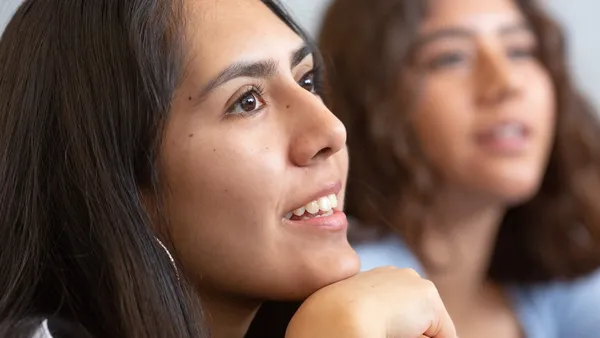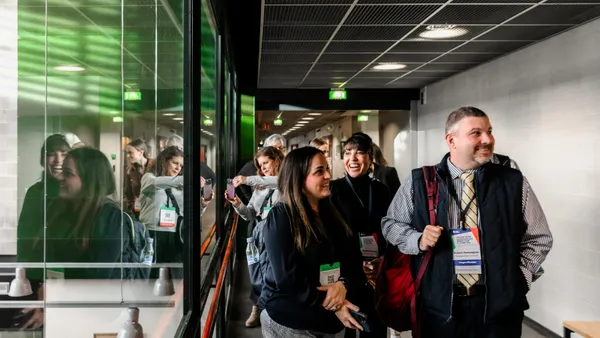“It's been the most powerful learning of our professional lives,” said Christy Northway, assistant superintendent of Surrey School District in British Columbia.
Northway is one of 20 education leaders from 10 school systems in Digital Promise’s Global Cities Education Network (GCEN) and League of Innovative Schools Whole Child Development Implementation Cohort. The implementation cohort model is built on the power of collaborative learning with and from education systems and leaders from around the world. Participants all face similar challenges and have a shared commitment to driving sustainable change.
These leaders embarked on a week-long, international study tour in Helsinki to explore how the Finnish education system supports whole child education. There, they explored practical strategies and solutions to shared challenges, like how to meet the needs of learners struggling with a sense of belonging, what it looks like to tailor education to address learner variability, and how to address the lasting academic and mental health effects of the pandemic.
Fostering Belonging Through Intentionality and Focus
From the moment she arrived at a school site visit in Helsinki, Northway was struck by the palpable focus on community. The cultural difference in mindset around schooling was especially noticeable in the language the Finnish educators used and how that reflected their values and priorities. No one talked about “the school.” Rather, they spoke about the space as a home, with everyone in the learning community being “in the family.”
“When they welcomed us, they welcomed us into ‘the house’ and there was this immediate sense of family…we’re taking off our shoes because it’s a house, and it just changes your mindset when you walk in. The first thing we noticed, having come in at a break time, was that there were staff sitting at tables with students, all having their mid-morning snack together. It wasn’t separate, with staff in a different staff room — it was just a sense of, ‘we are together.’” And even when structured learning started, “there was a fluidity with students moving seamlessly between different-aged peer groups, just as you do in a family.”
From the design of the space to the words used to describe it, connection and community were intentionally integrated into all aspects of the learning culture and environment, and it was evident in how students and teachers were interacting with each other.
“We thought about how it could be [in our own schools back home] because that sense of belonging – you couldn’t help but be swept up in it,” Northway said. “And for that period of time, we belonged as well. It was lovely.”
This issue of how to foster belonging and connection in schools was also top of mind for Luis Correa, superintendent of Gurnee School District 56 in Illinois, another trip participant.
“Post-pandemic, we saw a huge disconnect between home, school, and the student, and across the board, we're still seeing lack of connection and engagement from students in school,” he said. “We recognize there’s a critical need to redevelop a sense of belonging.”
In Helsinki, he was struck by how Finnish educators prioritize connection by keeping it simple. “In the States, and I’m guilty of it myself, we go after a lot of initiatives, adding a new STEM or AI initiative here, or new math and reading approaches there, and it overwhelms systems — not only teachers, but administrators and legislators. In Finland, what stood out to me is that there is a lot of complexity, but they ultimately pick and stick with one approach, do it really well, and that’s what gives them results.”
One of the schools he visited, for example, was a high-performing, low-socioeconomic status school with a diverse student population that reminded Correa of many schools in the United Status. Rather than chasing the latest technology or education trends, however, the clear focus of the school was on the power of strong relationships and the role each person plays in building a healthy school culture. Between adults, between students and teachers, and among students themselves, there were five simple tenets that were woven into the fabric of every interaction that the whole school community practiced everyday: gratitude, praise, listening, respect, and collaboration.
“It sounds so simple, but it works. Everything flows from that, and you can actually feel it in the school,” Correa shared.
Teacher Autonomy and Alternative Methods of Evaluation and Assessment
Both Northway and Correa also noted the empowering way in which the Finnish education system promotes teacher autonomy and alternative methods of evaluating and assessing student learning.
“The belief and trust in teachers was palpable, and it was interesting to see a system not mired in so many of the layers that sometimes we become consumed by,” Northway observed. “There absolutely was a belief and trust from a systems and community perspective that the teachers are professionals, they're working in the service and best interest of my child, and that it's solid, quality work.”
Correa also noted that, because teachers are thought of as professionals, they have the freedom to determine what they want their kids to learn and how they’re going to assess whether that learning happened.
“One of the things that I really liked about their system is the lack of emphasis on student testing, and the trust and autonomy they have with teachers. The reason why it works so well is because teachers are not pressured to look at their student data for growth through a test,” he said. For educators in the United States, he explained, even when schools and districts prioritize the list of 21st century competencies they want all students to have, like critical thinking, curiosity, and collaboration, “there’s a mismatch in what we measure and what we’re trying to develop in kids. That’s one of my major takeaways from Finland, because they measure what they actually are trying to teach.”
Correa is already figuring out ways to incorporate this shift in approach in his own district back home, starting with a cohort of 20 teacher leaders in his district. He plans to ask them to take a close look at the core competencies they’re prioritizing and encourage them to create their own assessment, while removing the pressure of the local assessment for their classes from the picture.
“Hopefully, what teachers will find is that we're allowing them to take risks and [that we trust] them to actually teach the skills that we want kids to walk away with while assessing those same skills,” he said.
Designing Learning for the Whole Child
“What we saw in Finland — developing positive relationships; having safe environments filled with belonging; offering a rich, high quality curriculum; developing skills, habits, and mindsets around learning; and providing an integrated support system — all of this is foundational to ensuring that each student is able to learn and thrive in schools to their full potential,” said Barbara Pape, senior director of the Learner Variability Project at Digital Promise. “The problem is, it’s nice to theorize about it but, how do you make it happen in a classroom and ensure that students with learning differences are included?”
This is why it’s particularly important for school and district leaders to have opportunities to see these practices in action for themselves. The members of the implementation cohort returned home from this transformative learning opportunity with ideas and strategies around how they might prioritize and operationalize different components of whole child development right away. Over the course of the next year, these education leaders will continue to collaboratively discuss shared problems of practice and receive continued support in implementing potential solutions with colleagues from communities around the world.
Are you interested in tapping into international learning opportunities with the League of Innovative Schools and the Global Cities Education Network? Sign up to be the first to hear about new opportunities!





 Dive Awards
Dive Awards




